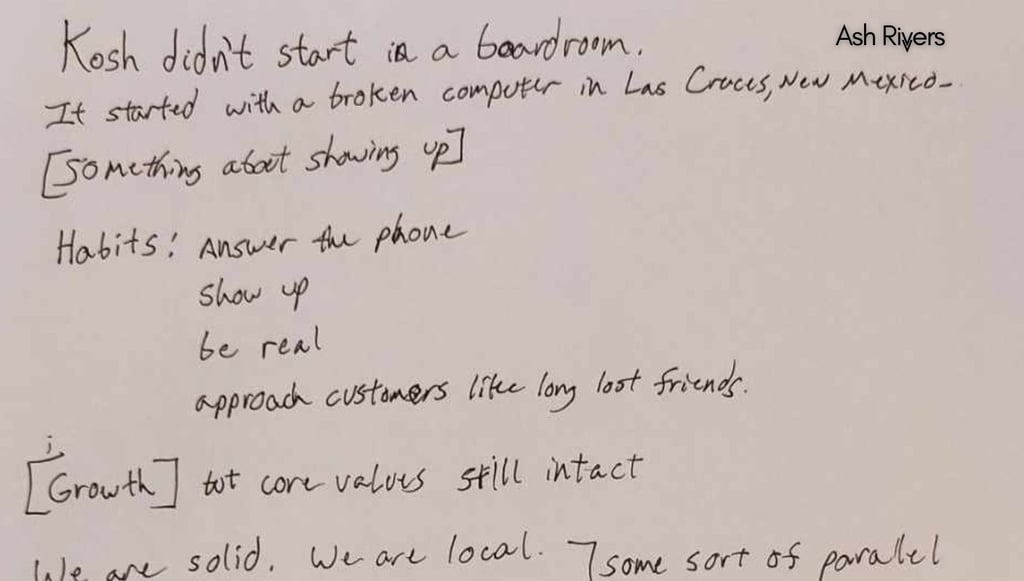This 114-Word Brand Story Helped My Client Get Aligned
I thought I was writing a short brand story. What I ended up delivering was clarity, cohesion, and a tool the whole company now uses to stay in sync.
Brandon Lee Alsup
4/2/20252 min read


I recently wrote a micro-brand story for my client, Kosh Solutions—a Managed Service Provider based in New Mexico. What started as a creative exercise turned into something much more valuable: a compass.
Most companies think of storytelling as something for big campaigns or origin documentaries. But at a certain stage—typically $1M+ in revenue, with a real team and a few scars—your story becomes a strategic tool. Not for the public, necessarily. But for you.
Here’s the version I wrote for Kosh:
This 114-Word Brand Story Helped My Client Get Aligned
No pitch deck. No startup swagger. Just a broken network in Las Cruces—and someone who needed help.
Kosh found its footing by showing up, solving problems, and treating people with respect.
That rhythm still guides everything we do.
Years later, our clients span states and time zones. But the standard is the same.
We don’t chase hype. We don’t outsource the care.
We invest in our people. We deliver on the promise.
Because good tech support is rarely loud.
It’s quiet confidence.
It’s clarity in the middle of chaos.
It’s knowing someone will pick up the phone.
That’s our story.
Not flashy—just the kind of partner you’re glad to have when it matters most.
That may read like a short brand story—but it ended up doing a lot more than we expected.
Within a week of finalizing this, the Kosh leadership team told me:
“This is the first time we’ve had a story that sounds like us.”
Kosh already had a mission and a strong culture—I wasn’t there to write a vision statement or values poster. I aimed to craft A story—with texture (geographic, history), tone (humble yet expert), and style.
Here’s how the micro-story started paying off:
Gave leadership a shared language to describe what Kosh is really about.
Showed up in hiring conversations, helping culture-fit candidates immediately understand the vibe.
Aligned the marketing tone, offering clarity on how we write, speak, and present Kosh.
Anchored our website messaging, sales intros, and internal onboarding.
In short: it didn’t just say what Kosh does. It showed how they show up. And that’s often what clients and employees are buying into—not the service, but the feeling of working with you.
What Makes a Micro-Story Powerful?
This isn’t about telling your entire history. It’s about capturing:
A real beginning (or symbolic one)
A clear ethos or habit
A present-day translation of that mindset
And a tone that feels undeniably like you
Think of it like a tuning fork: when struck, it helps everything else come into pitch.
Could You Write One for Your Business?
If you’re over $1M in revenue and trying to grow—this kind of story isn’t fluff.
It’s an internal compass. It helps you:
Communicate who you are in a way others can repeat
Hire and onboard more effectively
Align marketing with reality
Refocus on what’s timeless about how you serve
If you're not writing it down, you’re probably improvising—or worse, letting someone else write the story for you.
And like any good story, the best time to write it was probably six months ago.
The second-best time? Now.
MAKE CONTACT
Address
Las Cruces, NM 88007
575-642-8363
brandon@ashrivers.com




